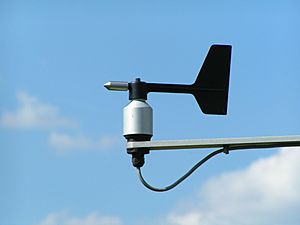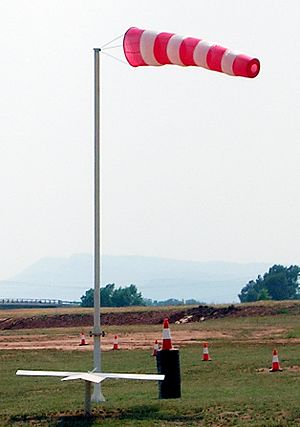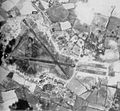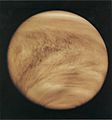Wind facts for kids
Wind is simply moving gas. On Earth, wind is mostly the movement of air. In outer space, we have solar wind. This is when gases or tiny particles move from the sun through space. The strongest winds in our solar system are found on planets like Neptune and Saturn.
Sometimes, wind blows in short, fast bursts. These are called gusts. Strong winds that last for about a minute are known as squalls. Winds that blow for a long time have many different names. Some common ones are breeze, gale, hurricane, and typhoon.
Wind can move land, especially in deserts. Cold wind can sometimes be bad for livestock (farm animals). Wind also affects how animals find and store food. It can change how they hunt and protect themselves.
Sunlight helps to power the Earth's atmospheric circulation. This creates winds that blow over land and sea. These winds then cause different kinds of weather.
When a High pressure area (which creates an anticyclone) is near a low pressure system (which creates a cyclone), air moves. It flows from the high pressure area to the low pressure area. This movement tries to balance out the pressures. The Coriolis effect makes these winds spiral around. A big difference in pressure can lead to very strong winds.
In some storms, like hurricanes, typhoons, cyclones, or tornadoes, winds can blow faster than 200 mph (320 kilometres per hour). Such strong winds can damage houses and other buildings. They can also be very dangerous for people.
Wind can also be caused by the rising of hot air. When hot air rises, it creates a low pressure area below it. Then, cooler air moves in to fill that space. When cold air drops, it creates a high pressure area. This happens because cold air is heavier than warm air. The cold air then flows out to balance the pressure with the surrounding lower pressure.
Wind is usually invisible. However, rain, dust, or snow can show us how it is blowing. A weathervane can also point out where the wind is coming from. The Beaufort scale is a special way to measure how strong the wind is. Sailors often use it when they are at sea and cannot see land.
When wind increases, it also makes evaporation happen faster. This means water turns into vapor more quickly.
Contents
How Strong Winds Can Cause Damage
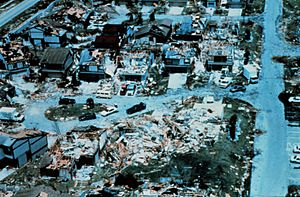
Very strong winds can cause a lot of damage. The amount of damage depends on how fast the wind is blowing. Sometimes, strong gusts of wind can make bridges move or even break them. A famous example is the Tacoma Narrows Bridge in 1940.
Electric power can fail because of wind. This can happen even if the wind speed is as low as 23 kn (43 km/h). This usually occurs when tree branches hit power lines. No type of tree can fully resist hurricane-force winds. However, trees with shallow roots can be blown over more easily. Some trees, like eucalyptus, sea hibiscus, and avocado, have brittle (easy to break) branches. These trees are damaged more easily by strong winds.
Understanding Trade Winds
The trade winds are a common pattern of winds. They blow from the east in tropical areas. These winds are found in the lower part of the Earth's atmosphere, close to the equator.
In the Northern Hemisphere, trade winds mostly blow from the northeast. In the Southern Hemisphere, they blow from the southeast. These winds are stronger during the winter. They are also stronger when the Arctic oscillation is in its warm phase. For centuries, captains of sailing ships have used trade winds to cross the world's oceans. These winds helped European countries expand into the Americas. They also made it possible to set up trade routes across the Atlantic and Pacific oceans.
The doldrums are found in the equatorial region. This is a wind belt where the air is warm. There are only small changes in air pressure there. Because of this, the winds are usually very light. Another name for the doldrums is the Intertropical Convergence Zone (ITCZ).
Wind in Outer Space
Wind in outer space is called solar wind. It is very different from the wind we feel on Earth. This wind comes from the sun or other stars. It is made up of tiny particles that have left the star's atmosphere. Like solar wind, planetary wind is also made of light gases. These gases have escaped from the atmospheres of planets.
Related Topics
Images for kids
-
Benjamin Franklin's map of the Gulf Stream, an ocean current.
-
A Hodograph plot of wind vectors at different heights in the troposphere, used to understand vertical wind shear.
-
Winds as described by Aristotle, an ancient Greek philosopher.
-
RAF Exeter airfield on May 20, 1944. This shows the layout of runways that help aircraft take off and land into the wind.
-
This wind turbine generates electricity using the power of wind.
-
Otto Lilienthal in flight, one of the first people to fly a glider.
See also
 In Spanish: Viento para niños
In Spanish: Viento para niños



